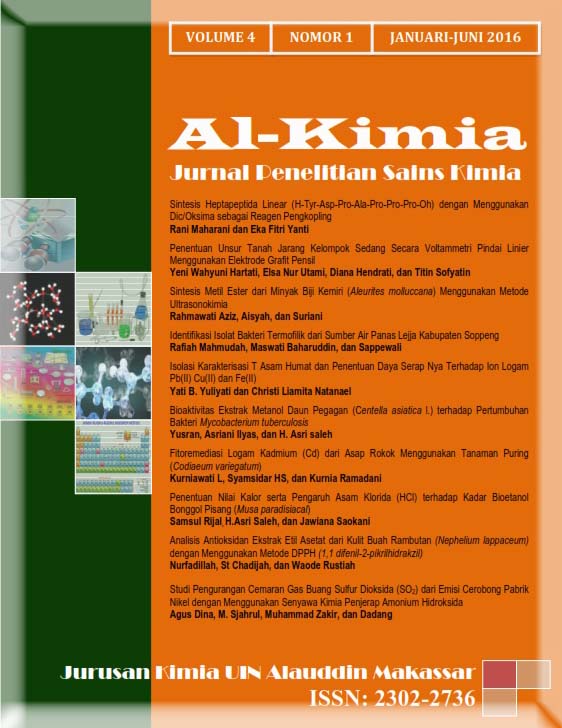Studi Pengurangan Cemaran Gas Buang Sulfur Dioksida (So2) dari Emisi Cerobong Pabrik Nikel dengan Menggunakan Senyawa Kimia Penjerapamonium Hidroksida
Abstract
Research on absorption of gaseous SO2 from factory emissions of nickel ore industry using solution of ammonium hydroxide has been done. Research conducted with variations including concentration, temperature, and time of contact. Variation of the concentration used were 1%, 2%, 3%, 4% and 5%; while variations of the temperature used were 20oC, 25oC, 30oC, 35oC, and 40oC; and the contact time were 10, 15, 20, 25 and 30 minutes. SO2 gas emissions sampling is done at a time when the factory operates at flow velocity and temperature conditions exhaust gas emissions. Results showed the greater concentration of the solution absorbing the greater the concentration of sulfur dioxide gas absorption, absorption temperature range between 30° C-40° C, and the longer the absorption of the greater number of SO2 absorption. A comparison of the percentage of the results of the average accumulation of absorption between absorbent solution (ammonium hydroxide) and slurry of calcium carbonate to reduce sulfur dioxide emissions to ambient air showed results still under the limestone slurry i.e. absorption capability comparison 95.00%: 62,91%. Difference in SO2 gas that is not absorbed out as emissions are still on top of the raw set quality standard (750 mg/m3). The gas is absorbed to form ammonium sulphate compounds that could be accommodated and packaged for commercialized as a by-product in the form of inorganic fertilizers valued economically. As such, ammonium hydroxide is used as an alternative to allow compound absorbent and produces no side residue so that the result is considered safe for the environment.Downloads
References
ANDAL, 2008. Dokumen Analisis Dampak Lingkungan Perusahaan Tambang Nikel Sorowako Kabupaten Luwu Timur, PT. INCO Tbk.
Gubernur Sulawesi Selatan, 2010. Peraturan Gubernur Sulawesi Selatan No. 69 Tahun 2010, tentang Baku Mutu dan Kriteria Kerusakan Lingkungan.BLHD Provinsi Sulawesi Selatan.
Hatch.,2010,Carbon Footprint of SO2 Scrubbing, PT. INCO, November.
Piter Sampetoding. Laporan Pelaksanaan RKL-RPL PT. INCO. 2006, 2008, 2009, 2010., PT. Vale Indonesia.
Presiden Republik Indonesia, 2011. Peraturan Presiden Nomor 61 Tahun 2011, tentang Rencana Aksi Nasional Penurunan Emisi Gas Rumah Kaca. Sekretariat Kabinet RI Deputi Bidang Perekonomian.
Priambodo, A., 2014. Laporan Pelaksanaan Rencana Pengelolaan Lingkungan Dan Rencana Pemantauan Lingkungan Tambang Nikel PT. Vale Indonesia.
PT Vale Indonesia, 2011.Fuel consumption and cloud seeding activities.
PT Vale Indonesia, 2010. Environmental Study Of Sulfur And Sulfate Concentration In Soil And Water Sorowako And Its Surrounding Area, Sorowako,.PT. Vale Indonesia.
Riyanto, M., 1995, Peralatan kontrol polusi udara. Teknologi Pengendalian dan pengukuran Polusi Udara di Industri, UPT-LSDE: BPP Teknologi.
Saeni, M.S.,1989. Kimia Lingkungan. Bogor: IPB Press.
Sjahrul, M., 2001, Kimia Lingkungan, Fakultas MIPA, Universitas Hasanuddin, Makassar.
Srivastava, R.,2001, National Risk Management Research Laboratory Research Triangle Part, NC.27711.U.S. Environmental Protection Agency, Research Triangle Park, North Carolina.
Sudrajad, Agung., Pencemaran Udara, Suatu Pendahuluan. http://io.ppi-jepang.org/article.php?id=111, Jakarta, 12 – 09 – 2006.
Superiadi, A., PT INCO, Juni 2010, Environmental Study of Sulfur and Sulfate Concentration in Soil and Water Sorowako and its Surrounding Area.PT. Vale Indonesia.
Authors who publish with this journal agree to the following terms:
1) Authors retain copyright and grant the journal right of first publication with the work simultaneously licensed under a Creative Commons Attribution License that allows others to share the work with an acknowledgement of the work's authorship and initial publication in this journal.
2) Authors are able to enter into separate, additional contractual arrangements for the non-exclusive distribution of the journal's published version of the work (e.g., post it to an institutional repository or publish it in a book), with an acknowledgement of its initial publication in this journal.
3)Authors are permitted and encouraged to post their work online (e.g., in institutional repositories or on their website) prior to and during the submission process, as it can lead to productive exchanges, as well as earlier and greater citation of published work (See The Effect of Open Access).


